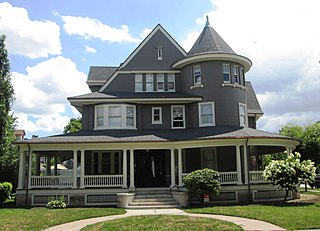
Prospect Park South is a small neighborhood in Flatbush, Brooklyn, New York City, located south of Prospect Park. It is included within the Prospect Park South Historic District, which was designated by the New York City Landmarks Preservation Commission in 1979 and listed on the National Register of Historic Places in 1983. The historic district is bounded by Church Avenue to the north, the BMT Brighton Line of the New York City Subway to the east, Beverley Road to the south, and between Stratford Road and Coney Island Avenue to the west.

The Old Dutch Parsonage is a historical house built in 1751, moved about 1913 and now located at 65 Washington Place, Somerville, Somerset County, New Jersey, United States. It was added to the National Register of Historic Places on January 25, 1971, and noted as "an excellent example of mid-18th-century Flemish Bond brick structure".

This is intended to be a complete list of properties and districts listed on the National Register of Historic Places in Orleans County, New York. The locations of National Register properties and districts may be seen in a map by clicking on "Map of all coordinates". Two listings, the New York State Barge Canal and the Cobblestone Historic District, are further designated a National Historic Landmark.

This list is intended to be a complete compilation of properties and districts listed on the National Register of Historic Places in Rensselaer County, New York, United States. Seven of the properties are further designated National Historic Landmarks.

Beverley Road is a local station on the BMT Brighton Line of the New York City Subway. It is located over a private right-of-way at Beverly Road between Marlborough Road/East 15th Street and East 16th Street in the neighborhood of Flatbush, Brooklyn. It is served by the Q train at all times.

Chatham–Arch is a neighborhood located immediately east of Downtown Indianapolis, Indiana, United States. This neighborhood is one of the oldest in Indianapolis, dating back to the mid 19th century. Chatham–Arch contains many of Indianapolis's historic homes.

Mount Morris Park Historic District was designated a historic district by New York City Landmarks Preservation Commission in 1971, and is part of the larger Mount Morris Park neighborhood. It is a large 16-block area in west central Harlem. The boundaries are West 118th and West 124th Streets, Fifth Avenue, and Adam Clayton Powell Jr. Boulevard. "Doctor's Row" comprises the nearby stretch of West 122nd Street, Mount Morris Park West and Malcolm X Boulevard; one of the doctors of "Doctor's Row" was the father of the composer Richard Rodgers. Mount Morris Square, the core of the district, is now called Marcus Garvey Park.

Chatham Village is a community within the larger Mount Washington neighborhood of the City of Pittsburgh, Pennsylvania, and an internationally acclaimed model of community design. It is roughly bounded by Virginia Ave., Bigham St., Woodruff St., Saw Mill Run Blvd., and Olympia Rd. It was declared a National Historic Landmark in 2005 as a remarkably well-preserved example of Garden City Movement design. The village is owned and operated as a cooperative by its residents.
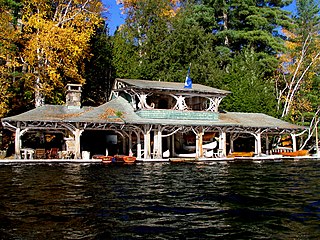
Benjamin A. Muncil was an American master builder in the Adirondacks early in the 20th century. He was a major figure in the architectural development of the Adirondack Great Camps; among his many projects was Marjorie Merriweather Post's Camp Topridge, Northbrook Lodge, and White Pine Camp, a summer White House of US President Calvin Coolidge.
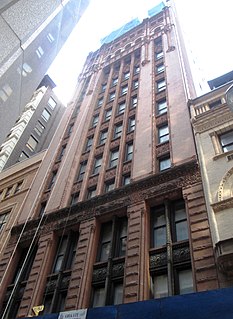
56 Pine Street – originally known as the Wallace Building after its developer, James Wallace – at 56-58 Pine Street between Pearl and William Streets in the Financial District of Manhattan, New York City, was built in 1893-94 and was designed by Oscar Wirz in the Romanesque Revival style.

There are 68 properties listed on the National Register of Historic Places in Albany, New York, United States. Six are additionally designated as National Historic Landmarks (NHLs), the most of any city in the state after New York City. Another 14 are historic districts, for which 20 of the listings are also contributing properties. Two properties, both buildings, that had been listed in the past but have since been demolished have been delisted; one building that is also no longer extant remains listed.

Stone-Tolan House is a historic home located at Brighton in Monroe County, New York. The 2-story frame house has a 1-story frame wing that is believed to have been built in 1792. It is a vernacular Federal-style structure and served as a frontier tavern, public meeting place, and pioneer homestead. The Landmark Society of Western New York acquired the property in 1956 to restore and preserve as a museum.

The Wallace Farm is a historic farm at 27 Wallace Road in Columbia, New Hampshire. Established in the late 18th century, the farm has been continuously held in the same family. The 125-acre (51 ha) includes a c. 1825 farmhouse, carriage house, and barn. It was listed on the National Register of Historic Places in 2001.
J. Foster Warner (1859–1937), also known as John Foster Warner, was a Rochester, New York-based architect. He was the son of one of Rochester's most prominent 19th century architects, Andrew Jackson Warner (1833-1910). After receiving his architectural training in his father's office, the younger Warner opened his own office in 1889 and remained in continuous practice until his death in 1937.
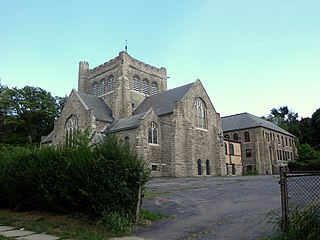
Christ Church New Brighton (Episcopal) is a historic Episcopal church complex at 76 Franklin Avenue in New Brighton, Staten Island, New York. The complex consists of a Late Victorian Gothic church (1904) and parish hall, connected to the church by an enclosed cloister, and a Tudor-style rectory.

Wallace K. Harrison Estate is a historic estate located at West Hills in Suffolk County, New York, the home of architect Wallace K. Harrison of the New York firm Harrison & Abramovitz. The estate home is a rambling, one story flat roofed concrete main house with a two-story circular living room near the center. It was built in 1929 in the International style. Also on the estate are a garage, two guest cottages, a studio, and a circular swimming pool. The property was purchased by Harrison and his wife in the early 1930s. Harrison bought a prefabricated house for $1000, the Aluminaire House, designed by A. Lawrence Kocher and Albert Frey for the Architectural League Show of 1931 in New York. He also embarked on the main house, which was initially built as a wing to what was called the "Tin House." As the complex grew the Tin House was relocated and became a guest cottage.
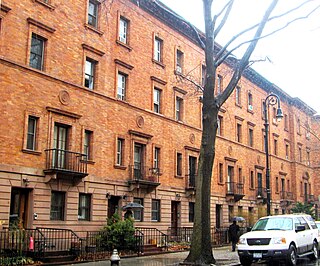
The St. Nicholas Historic District, known colloquially as "Striver's Row", is a historic district located on both sides of West 138th and West 139th Streets between Adam Clayton Powell Jr. Boulevard and Frederick Douglass Boulevard in the Harlem neighborhood of Manhattan, New York City. It is both a national and a New York City district, and consists of row houses and associated buildings designed by three architectural firms and built in 1891–93 by developer David H. King, Jr. These are collectively recognized as gems of New York City architecture, and "an outstanding example of late 19th-century urban design":
This is a timeline and chronology of the history of Brooklyn, New York. Brooklyn is the most populous of New York City's boroughs, and was settled in 1646.

The Elzy G. Burkam House is a historic house located in Sioux City, Iowa, United States. Built in 1894, it is an example of a transitional house between the revival styles popular in the 19th century and the Colonial Revival style that became popular in the early 20th century. The 2½-story brick and frame house was designed by Sioux City architect William D. McLaughlin. Its asymmetrical form was more common in the Colonial Revival style in the 1890s than it was after 1900. The house features round arch windows from the Romanesque Revival style, deep eaves with exposed rafters from the Stick Style, and it is capped with a hip roof with a dormer. The exterior of the first is covered with brick, while the second floor is covered with Clapboard. A conservatory dominates the south elevation.





















